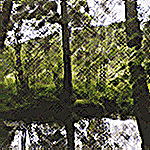encyclopedia
caligrean.com
We're authors
The Mar have fought the Drakes for resources for centuries, but even the wizards fear those rare times when the Drakes organize an invasion. To better understand why, read the book.
More than just authors
OTHER PROJECTS



HANGOUTS




COMICS




Konig worms
Konig worms are the most feared of all the manifestations of Dinah's Curse. These worms are not visible to the naked eye, but they are known to live in the mud of most of Marrishland's temperate areas. They can live anywhere where there is still water, since it consumes small amounts of organic material, but it thrives in warm, wet areas — most especially the flesh of warm-blooded animals. They cannot survive in fast-moving water, since they lack adequate means of propulsion to overcome a current.
Konig worms are capable of burrowing into flesh. Unlike leeches, their bite is not painless, though they are so small that several worms can often burrow into the soles of the feet without attracting the host's attention. A large number of burrowing konig worms produces an agony like having one's skin set on fire.
This pain is not fatal to the host, in itself, but a konig worm infestation is almost always followed by death. First, as they feed, konig worms kill the surrounding flesh, which often becomes infected soon after the infestation. Inexplicable infection without a visible wound is a clear sign of konig worm infestation. At this stage, amputation can often prevent the infestation from spreading enough to be deadly.
Second, konig worms are often swept through the blood stream, and while they are minute, they are too large to fit through human capillaries. Victims of konig worms often develop mysterious bruises in their extremities. A massive and fatal stroke as the konig worms block blood in the brain is usually inevitable.
Third, konig worms become highly prolific when they enter a host, laying eggs that hatch into new worms several days later. Not only do these eggs produce more konig worms — compounding the infestation — they often make their way into the blood. Individual eggs do not stop blood flow the way mature worms do, but in large numbers, they can give the blood an almost gel-like consistency, making it impossible for the heart to pump it effectively. In some cases, clumps of hundreds of eggs can clog major arteries or even interfere with the functioning of the heart or other major organs. Victims usually experience a shortness of breath or a tightness in the chest shortly before suffering a fatal heart attack, though this seldom happens before the unfortunate dies from the infection or a stroke.
Konig worms continue to spread through the host body even after the host has died. Anyone eating the flesh of the victim of a konig worm infestation without thoroughly cooking the meat is at risk of infestation. Konig worms cannot survive in the human stomach, but they can certainly burrow through the mouth and throat. Hosts who swallow live konig worms never survive the infestation, since it is not possible to cut away the infested area the way it is with a hand or foot infestation.
Most people who strongly suspect they have become infested by konig worms immediately seek a remedy for the infestation. Amputation is a common remedy in the case of a limb, as is cutting away the affected area, if possible. If the coverage of infestation is too great, or if the konig worms have burrowed into the head or throat, the most common remedy is suicide by the most expedient means available. It is also generally considered an act of mercy and duty to swiftly kill a victim of a fatal konig worm infestation. Despite superstitions about konig worms, not every fall in a puddle or splash of mud results in infestation, and it is likely that more people have died out of fear of infestation than have actually been killed by konig worms.
(Contributed by Weard Girdag Langat)



